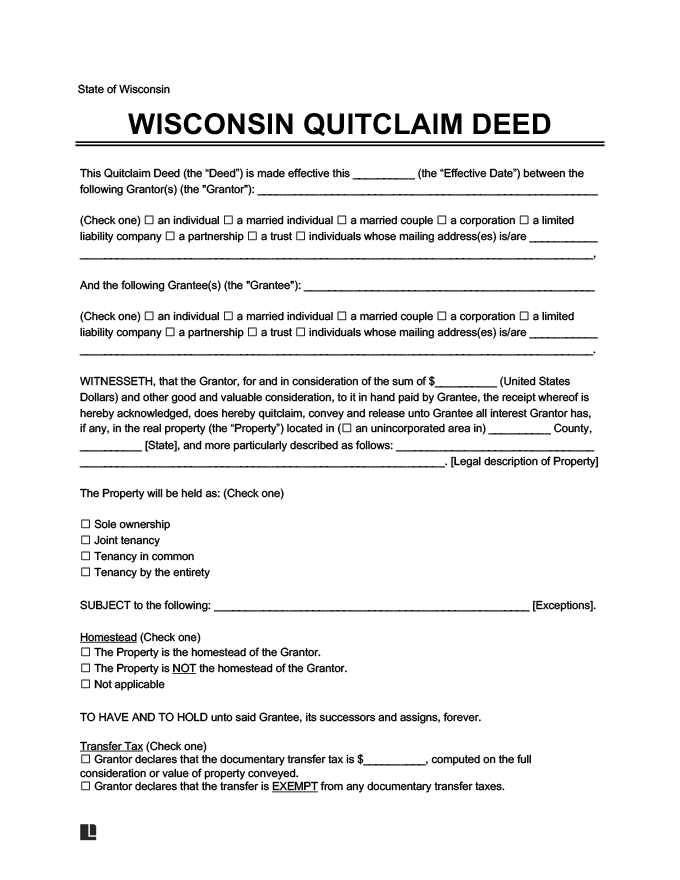A Wisconsin quitclaim deed provides the details of a simplified property transfer, which doesn’t have warranties and may not need a complicated discovery process. Read on to learn about Wisconsin quitclaim deed requirements so you can enforce the one you create.
Legal Framework
Wis. Stat. § 706.10(4) lays out the legal framework for quitclaim deeds. It notes that there is no specific language required for the deed but does require the avoidance of any language laying out warranties or covenants. The grantor should use the term “quitclaim” for clarity.
Legal Description
Wis. Stat. § 706.05 states that a quitclaim deed must contain a full legal description. A legal description usually includes measurements, boundary lines, distances, angles, and landmarks to clarify the property’s location and scope. It should exclude confusing or ambiguous language.
Signing
Wis. Stat. § 706.06 requires the grantor to sign their quitclaim deed and have a notary public authenticate it. Wisconsin does not require witnesses or the grantee’s signature to legalize the document.
Additional Documents
The grantor must attach an electronic Real Estate Transfer Return (eRETR) form when filing any quitclaim deed.
Filing
Under Wis. Stat. § 706.05, the grantor should record the deed with the Register of Deeds in the county where the property lies. Wisconsin requires the grantor to pay a filing fee during registration. Usually, this fee is $30, but some counties may set their own rates.
Community Property
Wisconsin community property law (Wis. Stat. § 766.587) divides marital property into two categories:
- Community property: Community property is any property acquired during marriage due to the efforts of either or both spouses, such as certain appreciation of property, income from property, life insurance, deferred employment benefits, and wages.
- Separate property: Separate property includes property acquired before marriage, acquired by inheritance or gift during marriage, or recovered through a personal injury claim during marriage.
You must distinguish separate property from community property when transferring it to promote clarity and prevent legal issues.
Validity Requirements
Quitclaim deeds must abide by state standards to be valid (Wis. Stat. §59.43(2m)(a) and (b)):
- Appear on printed white paper of at least 20-pound weight.
- Be 8.25 inches in width and either 11 or 14 inches in length (the permitted deviation is 0.25 inches).
- The ink must be red, blue, or black, but coded notations on maps and signatures can be different colors.
- Have unbound pages.
- Be legible and reproducible for copy-making purposes.
- Contain a top margin of at least 0.50 inches for each page.
- Contain bottom and side margins of at least 0.25 inches.
- First-page requirements must include the following:
- The deed’s title.
- Space for the document number.
- The return address.
- Space for the recording stamp.
- The parcel identification number.
Content Requirements
- A legal description of the transferred property (including its boundaries and location as its title specifies).
- The grantor’s name and address.
- The grantee’s name.
- The document preparer’s name.
- The consideration for the property (if any).
- The conditions or contingencies that could impact the property conveyance(if any).
Quitclaim Deeds vs. Other Property Transfer Methods
| Quitclaim Deed | Facilitates the conveyance of ownership rights in a property from one party to another without asserting any guarantees about the grantor's ownership or the absence of encumbrances. |
| Warranty Deed | Conveys ownership rights in a property from one party to another, affirming the grantor's clear ownership and providing assurances against any claims on the title. |
| Deed of Trust | Entrusts ownership rights in a property to a trustee until the borrower repays the loan, after which the title goes to the borrower, with foreclosure options if the borrower defaults. |
| Transfer on Death Deed | Directs the transmission of ownership rights in a property to designated beneficiaries upon the owner's death, bypassing probate. |
| Executor's Deed | Transfers ownership rights in a property from a deceased person's estate to a beneficiary in the deceased person's will. The probate court may determine the beneficiary if the will doesn't state one. |
